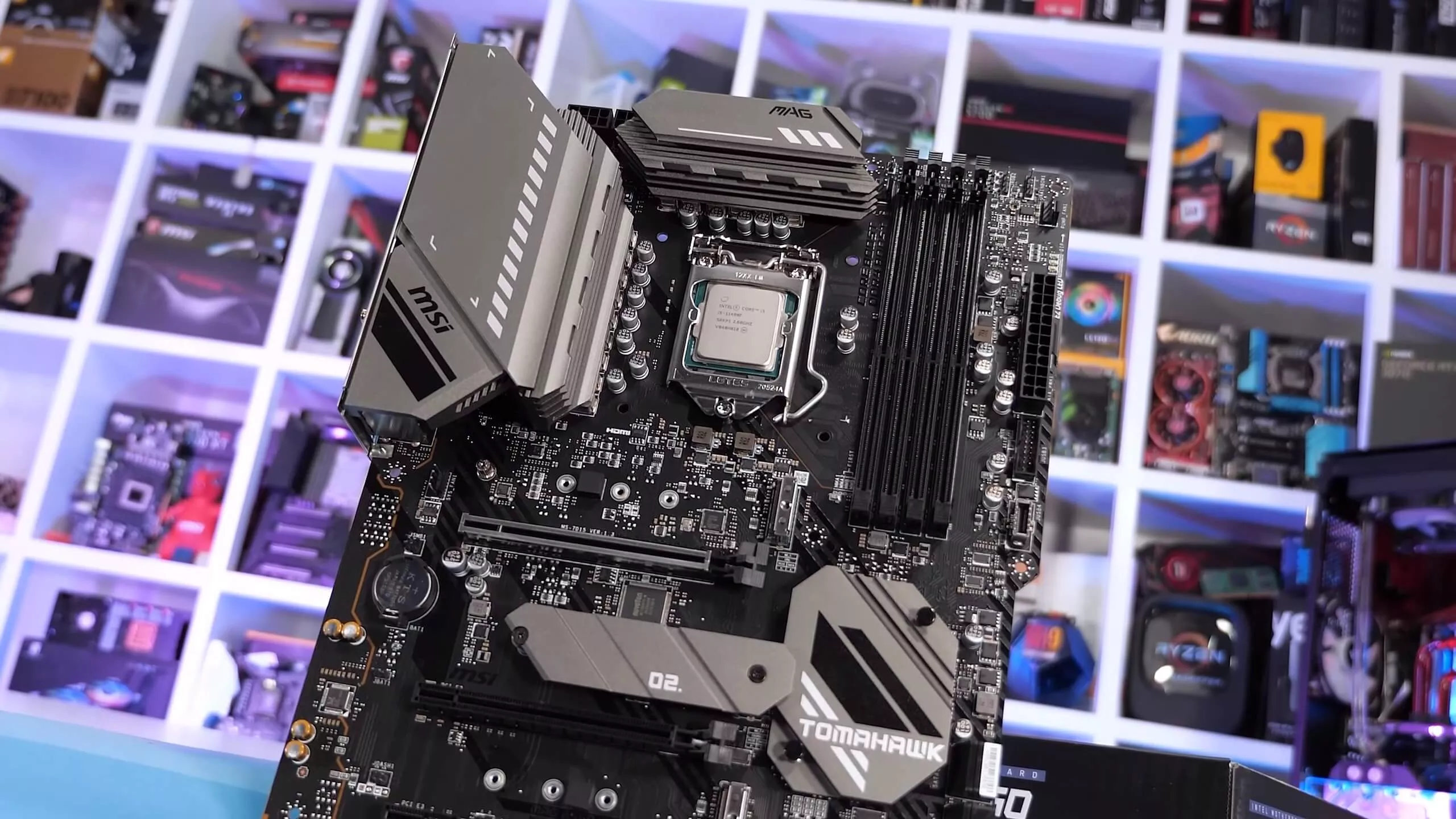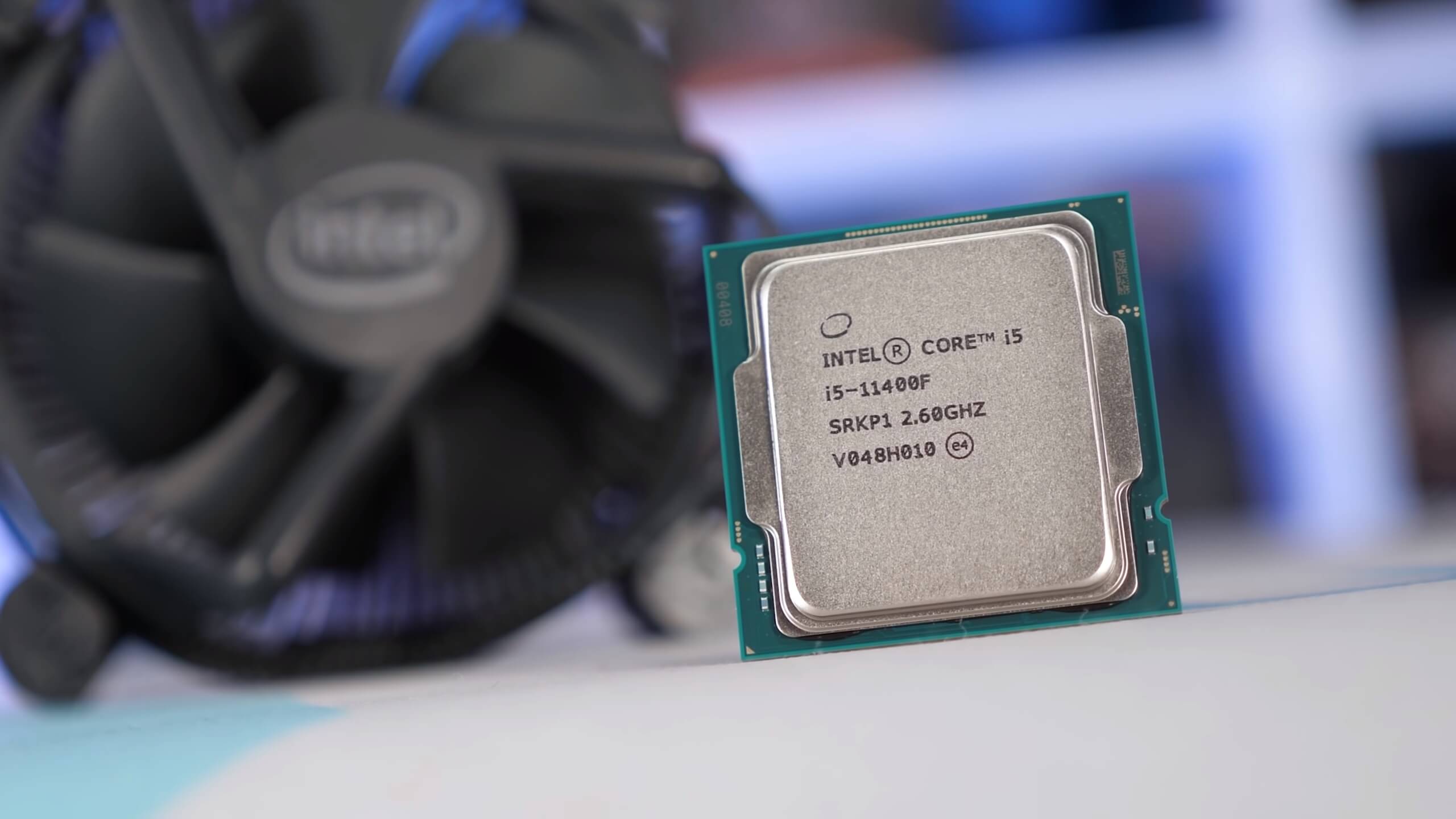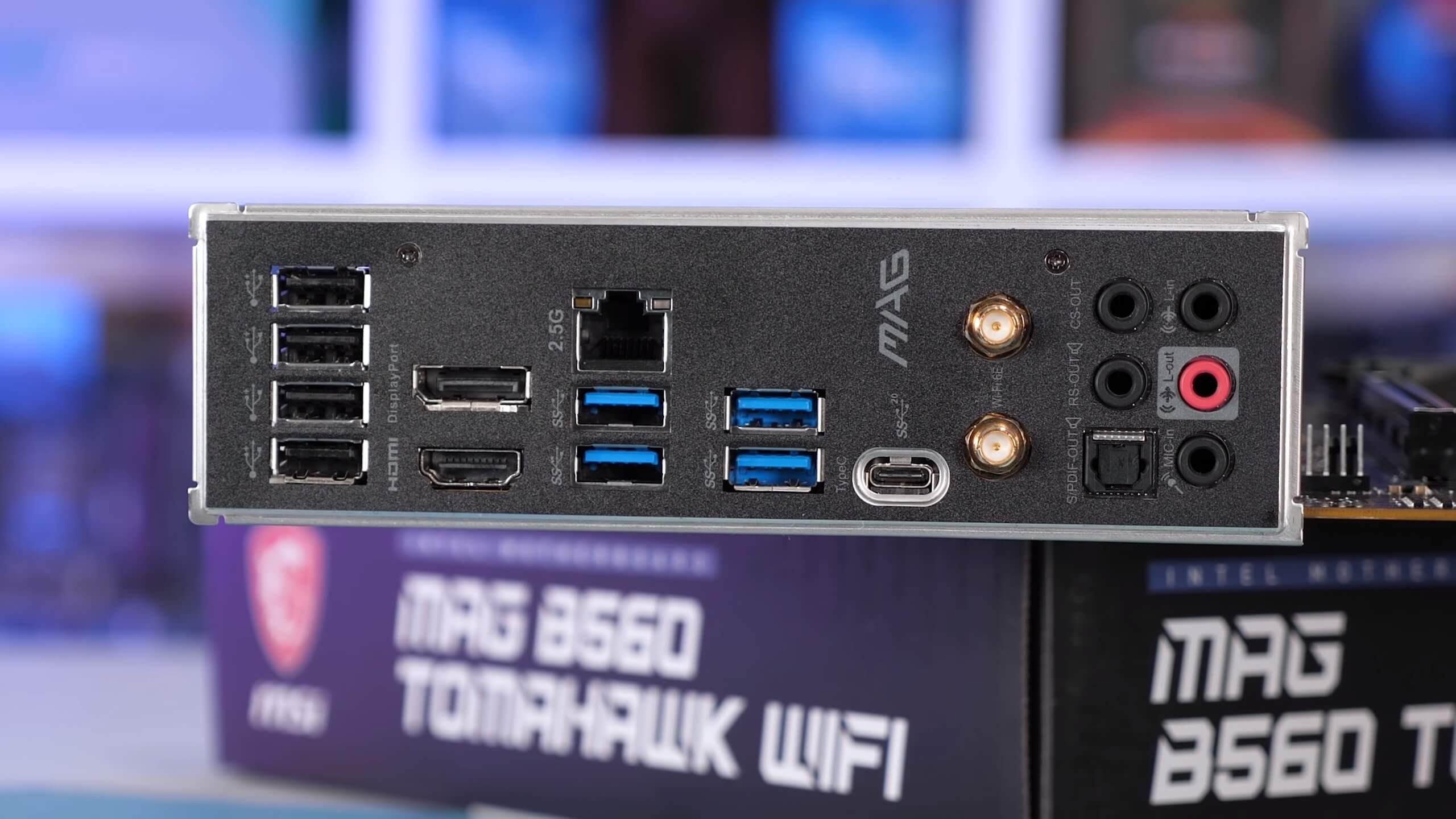Today we're taking a look at the new Core i5-11400F together with the MSI Tomahawk B560 motherboard. These two make for an interesting build configuration, as it's significantly cheaper than the Core i5-11600K/Z590 combo Intel sent us for our day-one Rocket Lake review. Although the 11600K fared well, I wasn't particularly enthusiastic about that combo as it failed to beat AMD's Ryzen 5 5600X in terms of performance nor value.
The Core i5-11600K is priced at $270, while a decent Z590 motherboard can be had for around $200, resulting in a total cost of $470. The Ryzen 5 5600X is overpriced at $300, but you can pair it with a decent B550 board for a total cost of $440, making it not only faster, but also cheaper. As we discussed in our review not so long ago, even cheaper is the previous-gen Core i5-10600K for $220, which can be paired with a decent Z490 board for $180, resulting in a total cost of $400, though I'd argue for $40 more the Ryzen option remains a better deal. But then, if you shoot for the 10th-gen 10400F for just $155 and stick that on a lower end Z490 motherboard like the MSI Z490-A Pro, the total cost is just $330.
Bearing that in mind, the new i5-11400F might be the go-to value option in the Rocket Lake series. We bought one for $175 ($20 more than the 10th-gen), but it does offer a few nifty features such as 20 PCI Express 4.0 lanes, faster DDR4 memory and USB 3.2 20 Gbps support. The B560 motherboards also support memory overclocking, something that wasn't available on B460 boards.
Now, the MSI B560 Tomahawk is not cheap. While there are B560 boards that cost as little as $100, they're very light on features. The well-equipped boards start at around $180 and the Tomahawk currently comes in at $200. At that point, it might be best to just buy a Z590 board. Though be aware in order to receive the same level of features offered by the B560 Tomahawk, you generally need to spend around $240 or more when going Z590.
| Core i5 11400 |
Core i5 11400F |
Core i5 11500 |
Core i5 11600 |
Core i5 11600K |
Core i5 11600KF |
|
|---|---|---|---|---|---|---|
| Price MSRP | $182 | $157 | $192 | $213 | $262 | $237 |
| Current Retail | $185 | $175 | $220 | $290 | $270 | $300 |
| Cores / Threads | 6 / 12 | |||||
| Base Frequency | 2.6 GHz | 2.7 GHz | 2.8 GHz | 3.9 GHz | ||
| Max Turbo | 4.4 GHz | 4.6 GHz | 4.8 GHz | 4.9 GHz | ||
| L3 Cache | 12 MB | |||||
| iGPU | UHD 730 | N/A | UHD 750 | N/A | ||
| TDP | 65 watts | 125 watts | ||||
So while the Z590 chipset supports twice as many PCI Express lanes and more USB 3.2 ports, you generally have to spend more on a motherboard to take advantage of those extra features. In short, there isn't a $200 Z590 motherboard that offers what the B560 Tomahawk does.
It's also worth noting that overclocking is typically deemed as a key advantage of Z-series motherboards, but I feel that's no longer a valuable feature. That's because the K SKU parts are clocked so aggressively out of the box that there's basically no overclocking headroom left, and squeezing a few percent more out of them just makes an already hot CPU even hotter. Faster memory can help, but as I mentioned, that's no longer an exclusive feature of Z-series boards as the B560 chipset now fully supports memory overclocking.
Pairing a premium Intel B560 board like the Tomahawk with the Core i5-11400F will set you back around $375, or $45 more than the 10400F/Z490 combo, but the motherboard is far better equipped. If you went with a more entry-level option like the MSI B560M Pro-VDH WiFi for $140, the combo would set you back just $315, so depending on what kind of features you require it's possible to snap up an 11400F with B560 motherboard for a little over $300, about the price of a Ryzen 5 5600X.
Those are some of the options, and today we want to explore how competitive the Core i5-11400F and B560 combo is.
The Core i5-11400F is a 6-core/12-thread CPU featuring a 12MB L3 cache. It clocks as high as 4.4 GHz which is a 10% reduction in turbo frequency when compared to the 11600K, though it's the base clock where we find the biggest difference. Whereas the 11600K clocks no lower than 3.9 GHz, the 11400F can drop as low as 2.6 GHz as the TDP has been reduced to 65 watts.
That said, this limitation doesn't apply to our testing as the MSI B560 Tomahawk runs without the TDP limits in place, as do almost all the Z590 motherboards. So rather than manually enforce the power limits we'll be testing out of the box performance as that's what you'll see when using this hardware combo.
Our test systems were all configured with 32GB of dual-rank, dual-channel DDR4-3200 CL14 memory. Our B560 setup was powered by the MSI B560 Tomahawk and for the Z590 setup, the Gigabyte Aorus Z590 Master. We used the Corsair RM850x PSU and cooling was provided by the Corsair iCUE H150i for comparison purposes, though we did run some tests with the box cooler on the 11400F as well. Finally, a GeForce RTX 2080 Ti was used for productivity benchmarks, while gaming tests were conducted with the newer and faster GeForce RTX 3090.
Benchmarks
As usual we'll start with Cinebench R20, and before we discuss these results, I'll just mention that the 11400F ran at an all-core frequency of 4.2 GHz, and this same frequency was achieved on both the MSI B560 Tomahawk and Gigabyte Aorus Z590 Master. In comparison, the 11600K runs at an all-core frequency of 4.6 GHz, or 10% higher.

Here we see that those frequencies translate into similar performance margins as the 11600K was ~9% faster than the 11400F. The 11400F was also 6% faster than the Ryzen 5 3600, suggesting that the new Intel Core i5 processor will be faster for most productivity tasks when compared to the Zen 2-based Ryzen 5 processor. That's an important step forward for Intel as the 10400F was quite a bit slower than the R5 3600.
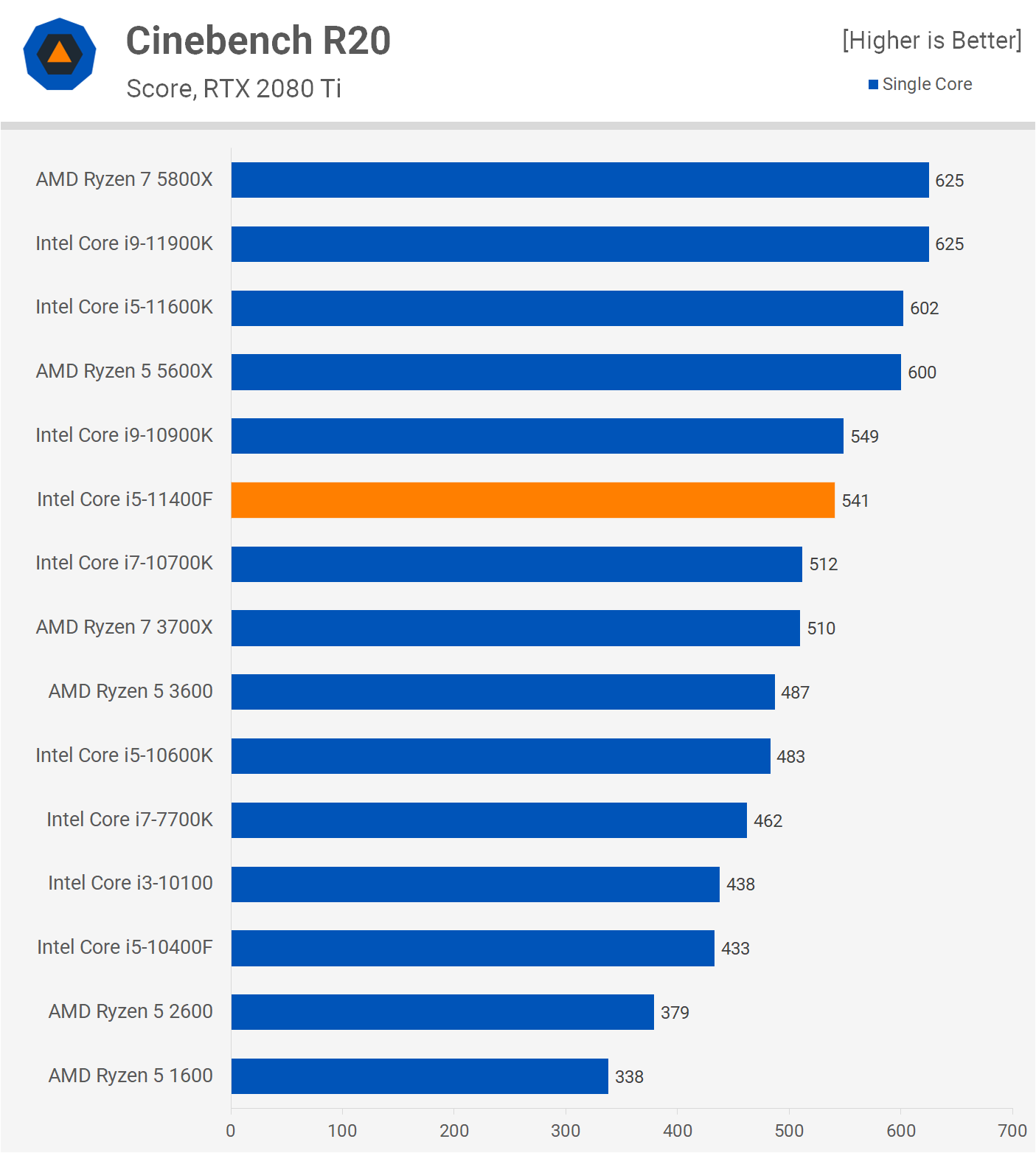
When compared to the 10400F, we're looking at a 24% performance uplift for the 11400F, so quite an impressive improvement there. The single core margins are much the same, here the 11600K was 11% faster than the 11400F while the new 11th gen Core i5 was 25% faster than the 10th gen version, the 10400F.
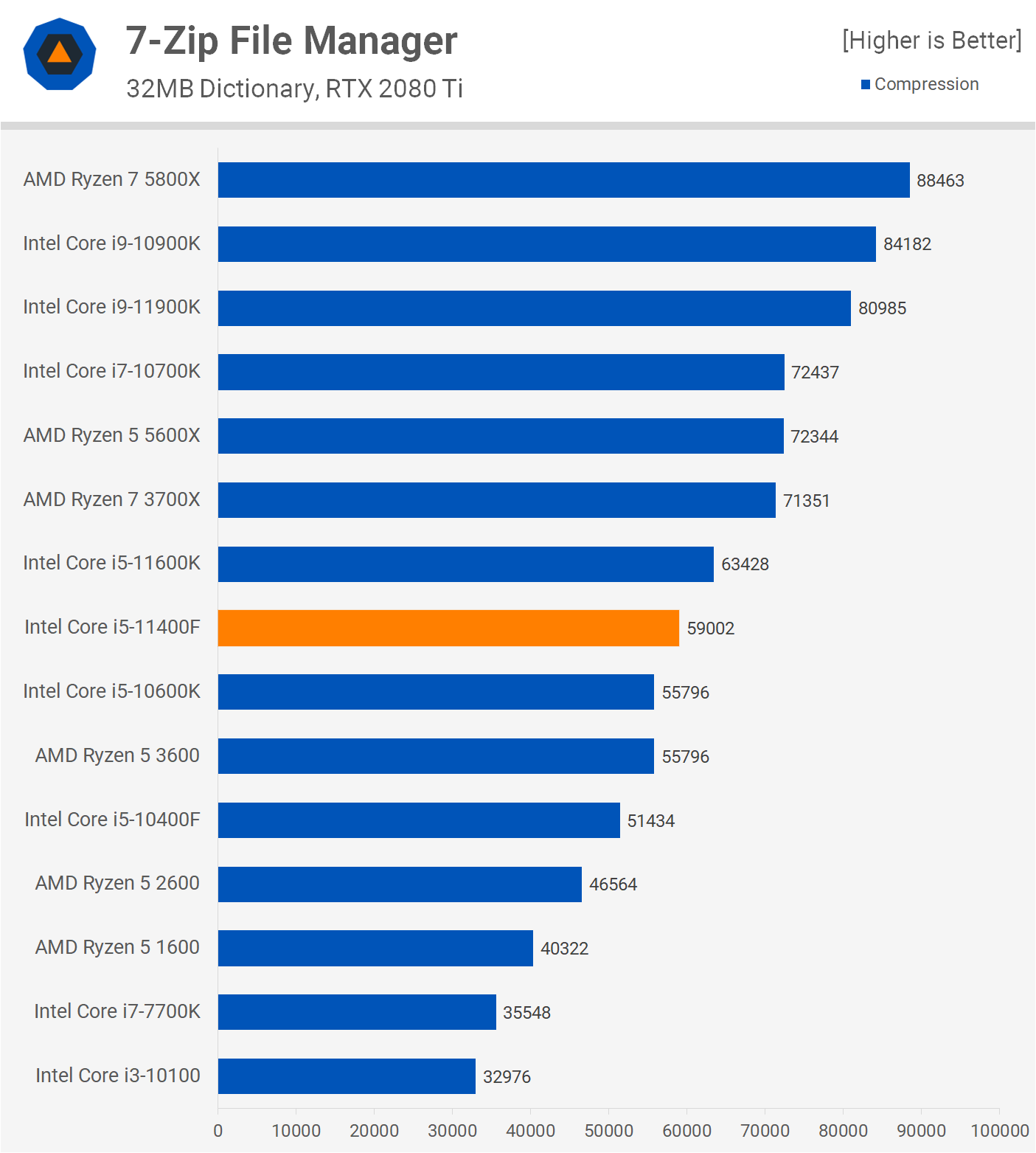

Moving on to 7-zip, we see that the 11600K is just 8% faster than the 11400F when comparing compression performance. That's a great result for the new Core i5 processor as it meant it was faster than both the 10600K and R5 3600, while improving upon the 10400F's performance by a 15% margin.
The decompression margins relative to the Intel CPUs remain much the same, the 11400F was 8% slower than the 10600K but 17% faster than the 10400F. It does lose out to the R5 3600 here, and that's a result of AMD's SMT implementation being more efficient for this workload.

The AES encryption performance is what you'd expect it to be based on what we saw with the 11600K, here the 11400F was 11% slower placing it ahead of even the 10900K and that means we're looking at a massive 46% performance uplift from the 10400F.
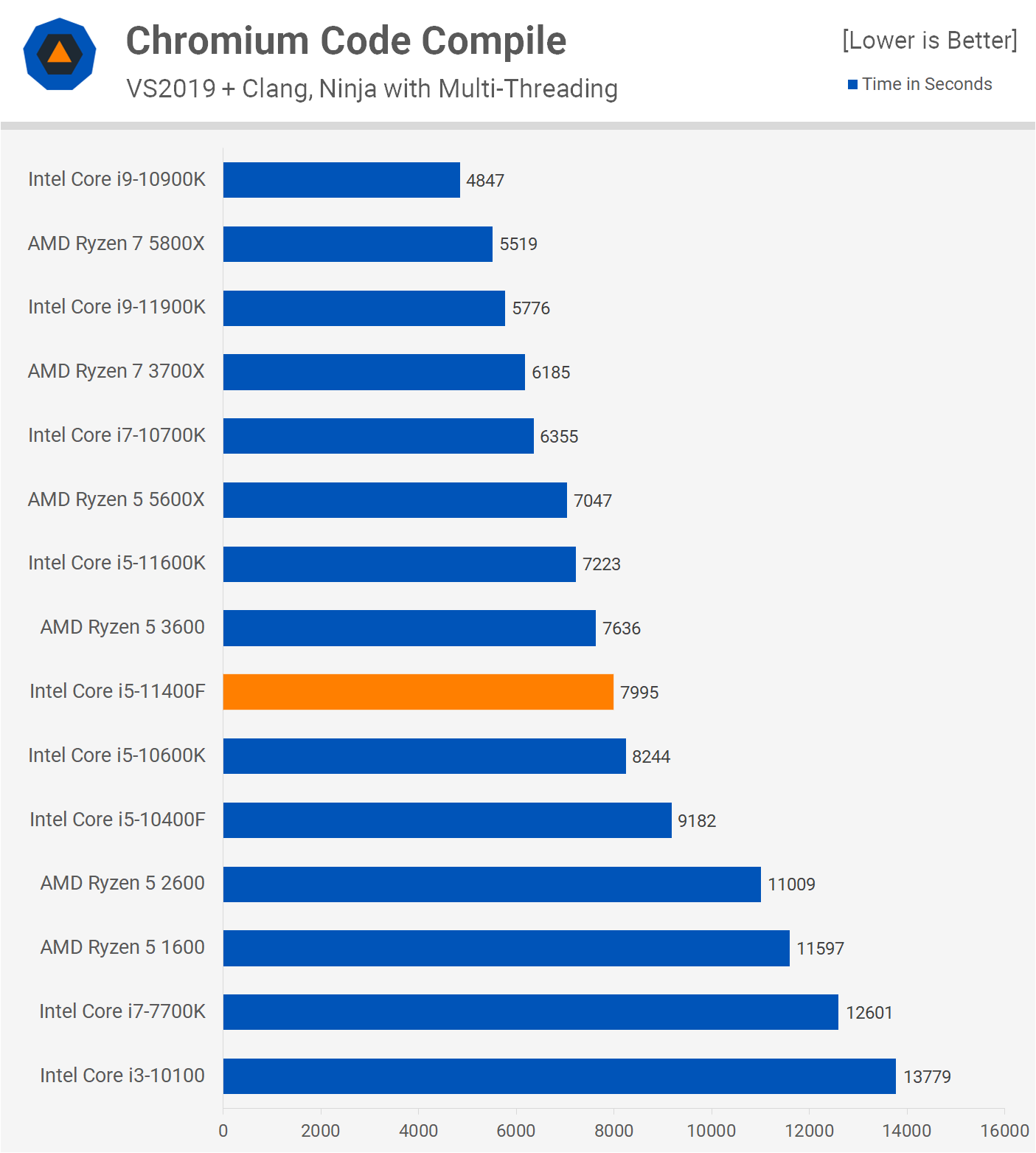
We're looking at a 10% reduction relative to the 11600K for code compilation performance and while that makes the 11400F slightly slower than the Ryzen 5 3600, it was faster than the previous generation 10600K and 15% faster than the 10400F.

The performance difference between the 11600K and 11400F is virtually non-existent when testing with DaVinci Resolve Studio, here the locked Core i5 part was just 3% slower. Again that meant it wasn't just faster than the previous generation 10400F, but also the 10600K.
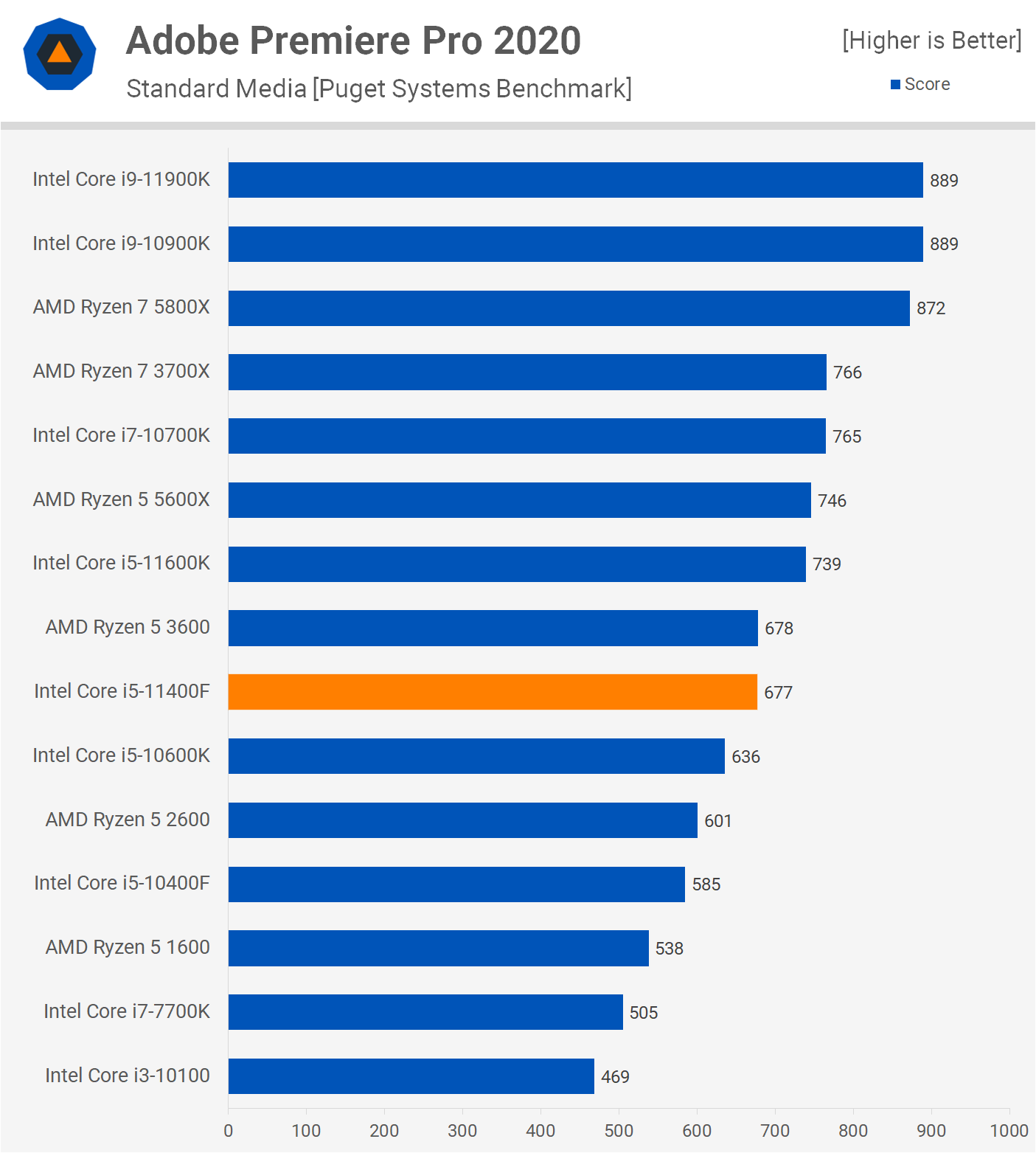
Premiere Pro tends to leverage the CPU more than Resolve and as a result the 11400F was 8% slower than the 11600K. Still, given it's ~35% cheaper, that's a great result for the locked i5 part.

In Adobe Photoshop we see similar margins to previous tests. The 11400F is 7% slower than the 11600K, meaning it's faster than not just the 10400F, but also the 10600K and even the 10700K.

The last application test is Blender where the 11400F is just 9% slower than the 11600K and again that's an impressive result as it meant this new sub $200 processor is faster than the previous generation 10600K and Ryzen 5 3600.
Power Consumption

The 11400F reduces total system consumption by 18% when compared to the 11600K, which is a great result given considering it's just 9% slower in this test. When compared to AMD's latest and greatest, that's not particularly impressive given the 11400F pushes total system usage to the same level as the 5800X, but relative to Intel's own lineup it's good.
Gaming Performance
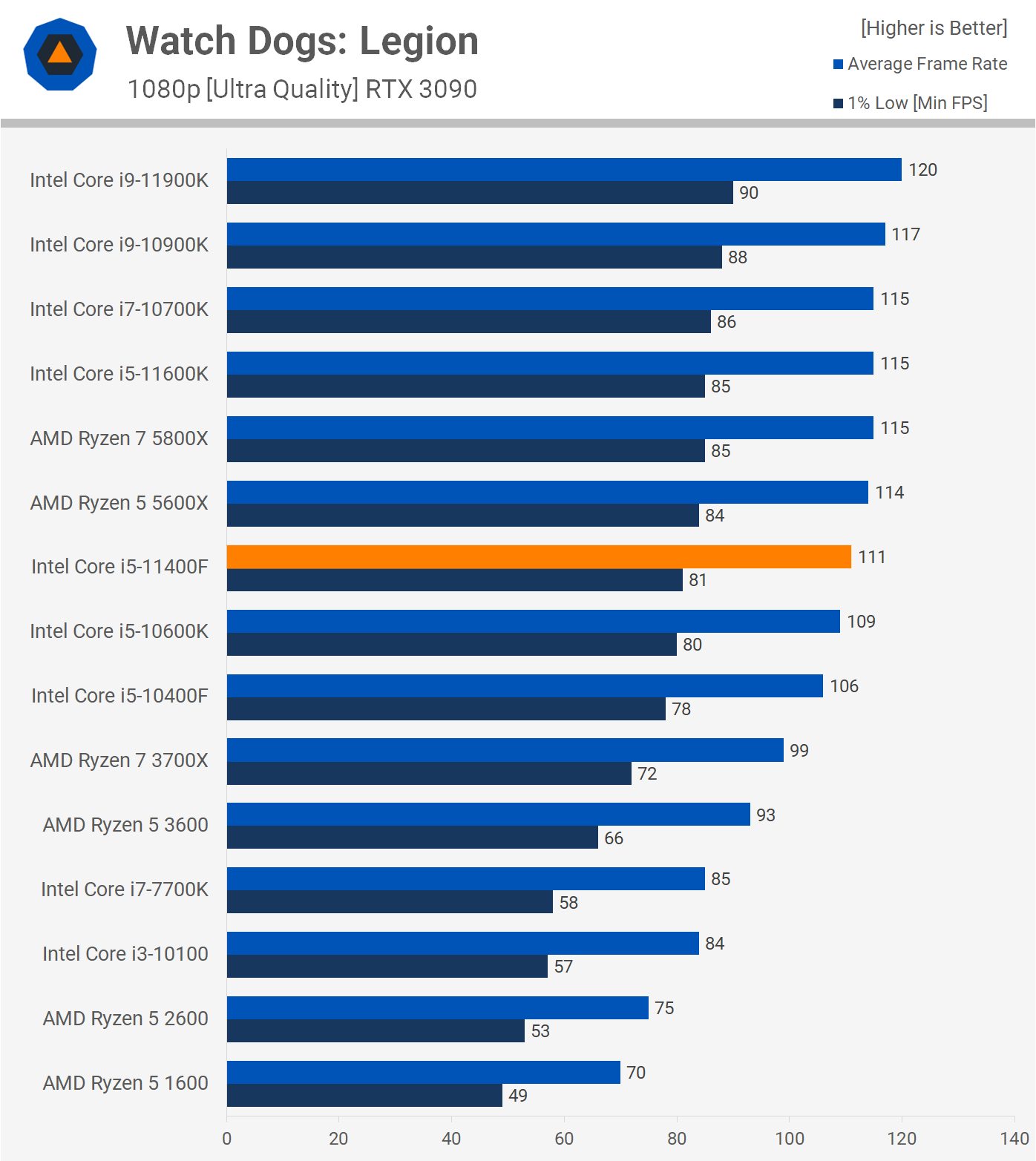
We'll start with Watch Dogs Legion for our gaming benchmarks, where the 11400F is 3% slower than the 11600K, making it slightly faster than the 10600K and just a fraction slower than the 5600X.

We're looking at just a 5% reduction in performance for the 11400F when compared to the 11600K in F1 2020 when comparing the average frame rate and a 3% reduction for the 1% low. The newer 11th gen processors actually perform worse than the previous 10th gen parts, so the 11400F came in slightly slower than the 10400F.

Moving on to Horizon Zero Dawn, we're looking at virtually identical performance between the 11600K and 11400F. The 11400F was 5% faster than the 10th gen version, not a huge performance increase, but at least it was faster in this title.

We're looking at identical performance between the 11th-gen Core i5 processors in Borderlands 3. This time the 11400F was just 3% faster than the 10400F, and given that we're using an RTX 3090 at 1080p, it goes without saying that under more realistic conditions there will be no difference between these two CPUs.

Interestingly, Death Stranding scales with frequency and as a result the 11400F was 10% slower than the 11600K, so a reasonably large difference, but even so the locked 11th gen Core i5 processor was still 7% faster than the previous generation model.
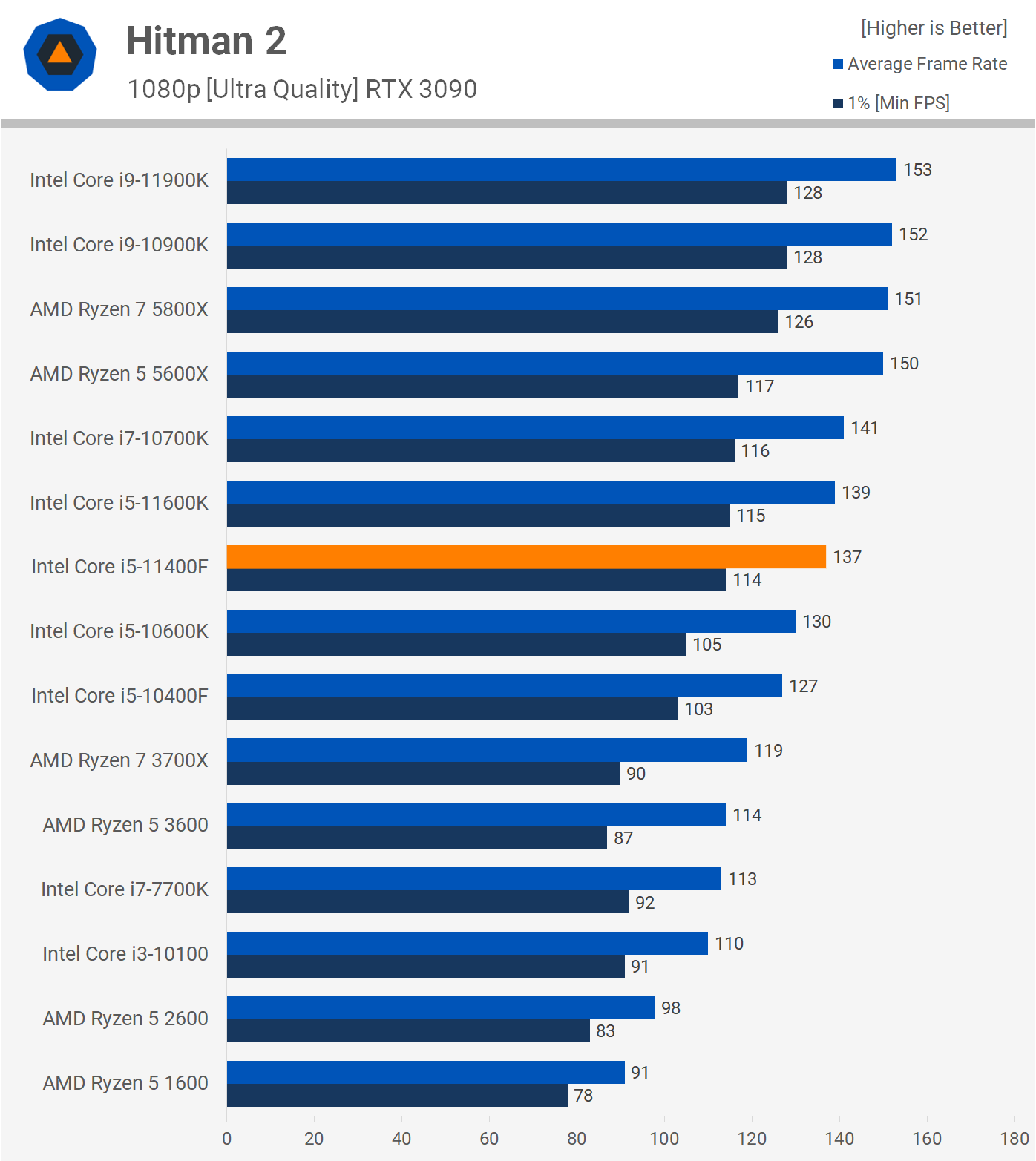
We're back to virtually no performance difference between the 11400F and 11600K with Hitman 2. The 11400F was 8% faster than the 10400F, too, so a reasonable performance uplift.

The 11400F was 6% slower than the 11600K in Star Wars Squadrons and that saw it fall behind the Ryzen 5 3600 and 7% behind the 10400F. Like F1 2020, Star Wars Squadrons is another game where the newer 11th gen Core processors are actually slower than the 10th gen models.

There's very little difference between the two 11th gen Core i5 processors in Serious Sam 4 and the 11400F was just 5% faster than the 10400F. When compared to the AMD processors, it was 11% faster than the R5 3600 but 15% slower than the R5 5600X.
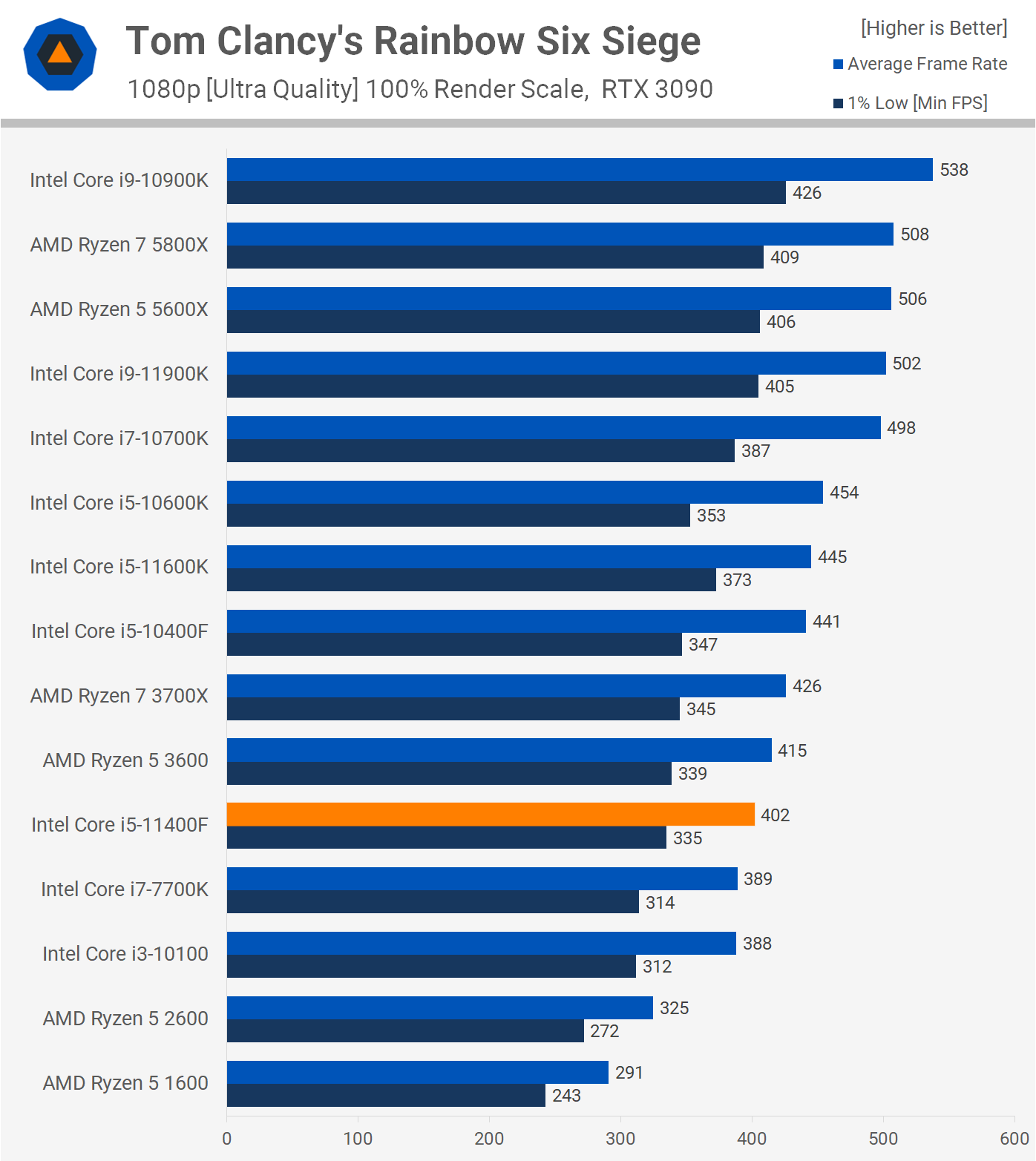
Rainbow Six Siege scales quite well with frequency and as a result the 11400F was 10% slower than the 11600K, and disappointingly 9% slower than the 10400F. This is another game where the 11th gen models are slower than the older 10th gen.

We're back to almost no performance difference in Shadow of the Tomb Raider between the 11600K and 11400F and that meant the F-SKU part was 9% faster than the 10600K and 13% faster than the 10400F.
Average Gaming Performance
Here's a look at our 10 game average. Given what we just saw it won't surprise you to learn that on average the 11400F was just 4.5% slower than the 11600K, when testing with an RTX 3090 at 1080p. On average, we're looking at 10600K-like performance and that means the 11400F is about 2.5% faster than the 10400F.

It's interesting to note that the 10th-gen 10600K was just 2.5% faster than the 10400F, whereas that margin basically doubled between the 11600K and 11400F. The reason for this is down to the much larger margins in Rainbow Six Siege and Death Stranding. For some reason these games are more clock sensitive with the 11th-gen models than they were with 10th-gen, likely down to architectural differences.
When compared to competing AMD parts, the 11400F is about 13% faster than the Ryzen 5 3600 and 11% slower than the 5600X, essentially slotting in between the two.
Avoid the Box Cooler
A few words about the shiny new box cooler in the Core i5, which is just the old box cooler with a new coat of black paint. Although this model features a copper slug, it's still woefully inadequate for use on boards that don't adhere to the TDP limits.
Installed on the MSI B560 Tomahawk using the default BIOS configuration, the 11400F peaked at just 52C using our Corsair iCUE H150i, a $220 cooler that we don't expect anyone to pair with an 11400F.
That said, a basic $20 tower cooler will work nicely. The box cooler quickly hit 100C and as a result the CPU started to throttle. Truth be told, this cooler is only designed to handle the 65 watt TDP configuration, and by enforcing the TDP limits it peaked at 70C, though even here it was still very loud. Our advice is to ignore the box cooler and budget an additional $20 for a basic tower-style cooler that will provide much better performance.
What We Learned
The new Core i5-11400F is marginally faster than the 10400F for gaming, but often much faster for productivity tasks with margins as large as 25% in certain tasks. For gamers, the 11400F isn't exactly a crazy good deal, at around $20 more than the 10400F, it's an insignificant cost increase and you can pair it with all the same motherboards, so we feel for the upgraded features alone the premium is worth it.
Now, for those of you more focused on productivity tasks, the 11400F is a no brainer. You'd always pick it over the older 10400F and really even the 11600K. In fact, there's no point in buying the 11600K at $270 regardless of your use case: you're faced with paying a 54% premium for at best ~11% improved performance, though it's often more like 5%. If we include the cost of a quality motherboard, the 11600K/Z590 combo is ~40% more costly, and again, you're not getting anywhere near that kind of performance improvement.
It appears that with mounting pressure from AMD, Intel's had to squeeze every last bit of performance out of their processors. That's left virtually no overclocking headroom, and so their premium K-SKU processors are rather pointless. Moreover, with memory overclocking supported on B-series motherboards, the Z-series range has also become a bit redundant.
So there you have it, Intel on a new position as the budget king. For Intel that's no doubt less than a desirable outcome, but for us it's not bad news as they're forced to offer parts like the Core i5-11400F and enable memory overclocking on budget motherboards.
As it stands right now, the Core i5-11400F on a B560 motherboard should be the go-to option for budget builders. Essentially you can snag this processor with an entry-level motherboard for less than the cost of the Ryzen 5 5600X. Also, the 11400F is in stock and should be easy to purchase for the foreseeable future, which is not something we can say about any of AMD's Zen 3 processors. What a crazy time we're living in.


